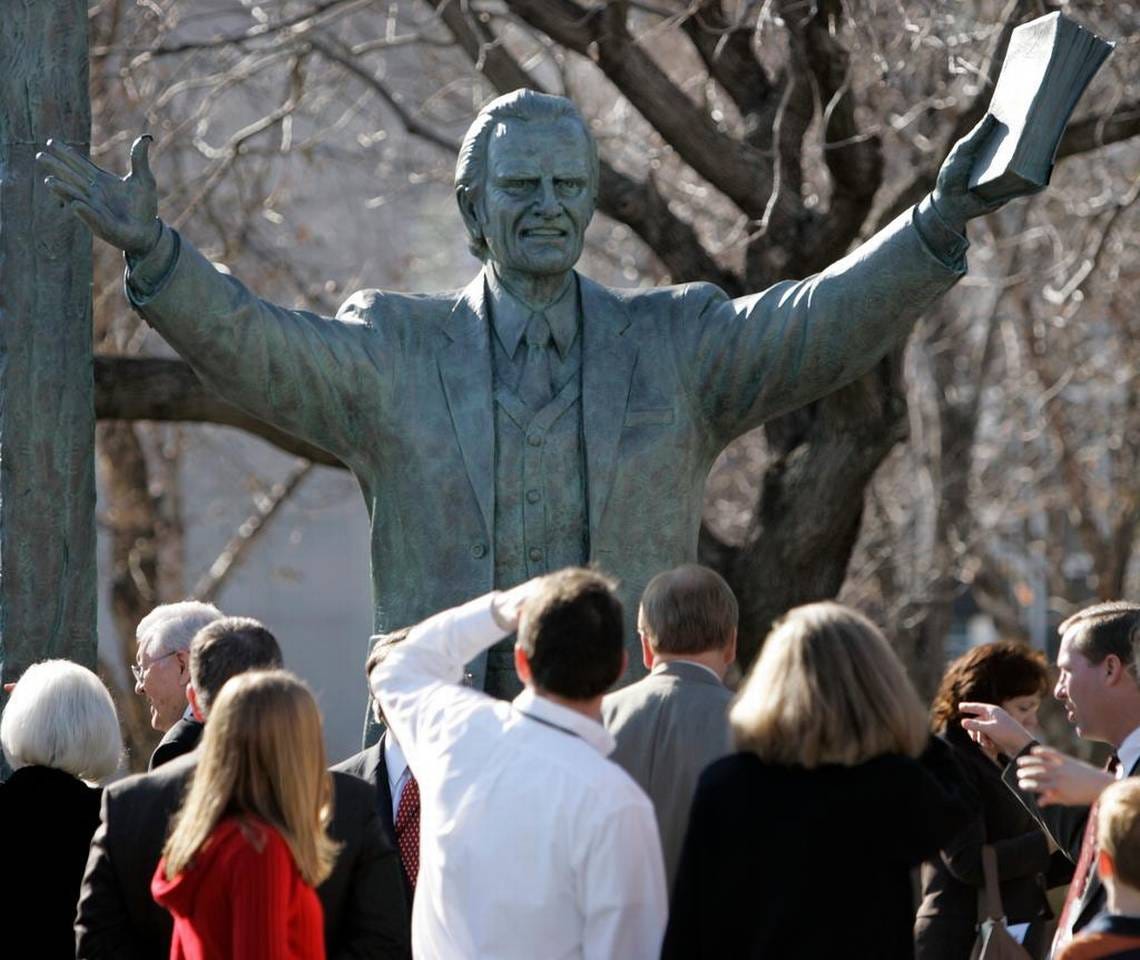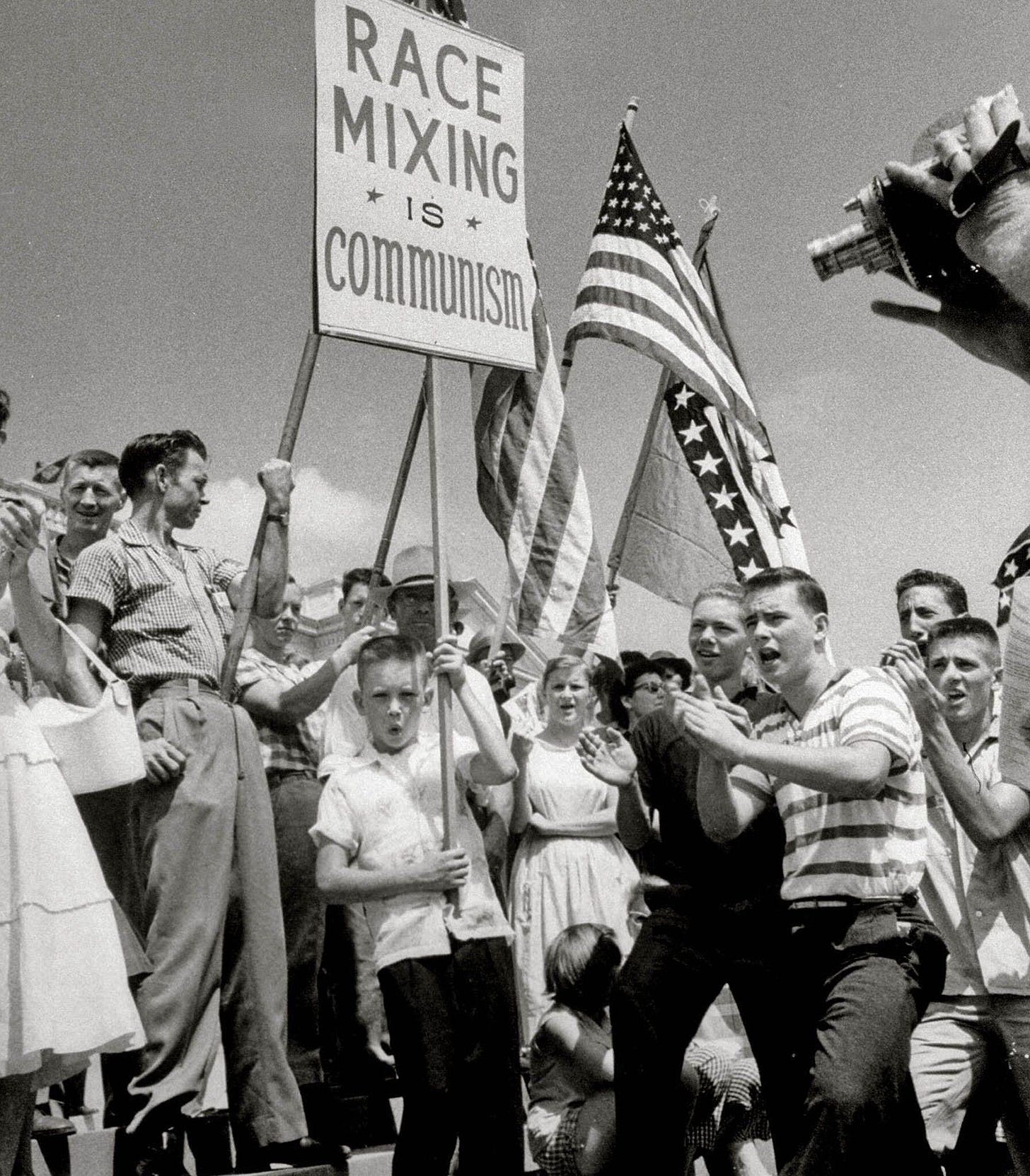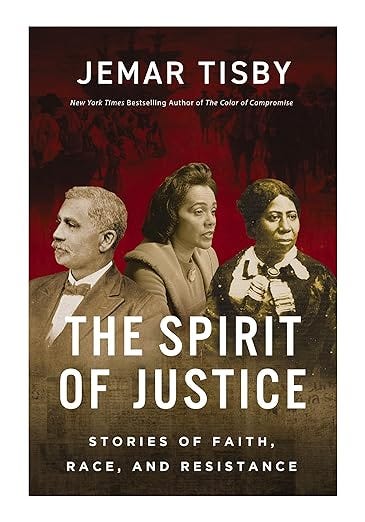Should Billy Graham Represent North Carolina in Statuary Hall?
His mixed record on race and links to white Christian nationalism beg the question.
I hope the article below provokes thoughtful conversation and consideration. Although thousands of people read these articles, only a very small percentage (in the single digits) actually support my work with funding. Would you consider becoming a paid subscriber today?
Today officials from North Carolina are installing a bronze statue of evangelist Billy Graham in Statuary Hall.
Statuary Hall is a room in the U.S. Capitol Building that displays figures from every state in the union, two per state. Figures include Amelia Earhart (KS), Chief Standing Bear (NE), and Gerald R. Ford (MI).
A statement from the North Carolina GOP about the Billy Graham statue read:
“The North Carolina Republican Party is pleased to see the statue of Rev. Billy Graham formally installed in the U.S. Capitol. We are proud to see a man of faith, who traveled the world to preach the Gospel of God's Son Jesus Christ, and loved his North Carolina home, honored in our nation’s capital.”
This honor has been a long time coming. Back in 2015, North Carolina governor, Pat McCory, signed a bill that declared Graham would be the state’s representative in Statuary Hall.
These statues are meant to both honor the individual and demonstrate how that person represents the ideals of the particular state.
In years past, installing a statue in Statuary Hall would have been an innocuous affair—a simple ceremony to demonstrate pride in one’s place of residence.
In recent years, however, these statues have come under scrutiny. Residents of each state have become more critical of the figures chosen, especially as it relates to their records on race and justice.
In the midst of the 2020 racial justice uprisings, for example, people questioned who should represent their state.
Florida replaced the statue of a Confederate leader with Mary McLeod Bethune, a Black woman who founded the National Council of Negro Women (NCNW) and what became Bethune-Cookman University. Arkansas replaced its racist representatives in Statuary Hall with singer Johnny Cash and civil rights activist Daisy Bates.
All of this leads to the question, “Should North Carolina represent Billy Graham in Statuary Hall?”
From one perspective, this isn’t even a question. Graham is a perfect representative of the state. From another angle, Graham depicts a view of religion and politics they reject.
Reasons Billy Graham SHOULD Be in Statuary Hall
1. Graham Is Well-Known
A person’s statue cannot be installed in Statuary Hall until they are deceased. When Billy Graham died in 2018 at the age of 99, he remained one of the most well-known religious figures of the past century.
He is said to have preached to at least 200 million people in 185 countries in his massive evangelist rallies. People during his decades of massive, often weeks- or months-long crusades.
He is surely one of, if the not the, most famous North Carolinian. For that reason alone, there is a strong argument to be made that his statue is the right one to stand in Statuary Hall.
2. Graham Is Popular
Being well-known is not a sufficient reason, by itself, for a person to’s statue to go into Statuary Hall. People must support that person and what they represent.
Graham certainly has his supporters. He is popular to thousands, hundreds of thousands, perhaps millions around the world.
In 2013, the state’s General Assembly voted Graham “North Carolina’s Favorite Son.”
More than 30 books are credited to Graham’s name, and he remained a fixture in American popular culture since at least his early crusades in the 1940s.
Many people can trace their conversion to Christianity to Billy Graham’s preaching, and he holds a tender place in their hearts.
The affection that many people in North Carolina have for Billy Graham is another reason in favor of his presence in Statuary Hall.
3. Graham Is Representative
Not only is Billy Graham a popular figure, one could make the case that he is singularly representative of an ethos in the region.
Graham is an old-fashioned, Bible-believing, All-American preacher.
From the twang in his speech, to his blonde-haired and blue-eyed features, to his devotion to God and family—in some senses, you really could not come up with a better individual representative of the collective religious culture of (white) North Carolina and the (white) South than Billy Graham.
From this view, Graham’s representation in Statuary Hall not only makes sense, it’s a no-brainer.
There are, however, some arguments against Graham’s place as a representative of North Carolina in the nation’s capital.
Reasons Billy Graham Should NOT Be Represented in Statuary Hall
1. His Stances on Race Were Mixed
While Billy Graham was not as racially prejudiced as some of his peers and contemporaries, at best, he had a mixed record on race.
He took down the ropes dividing Black and white participants at one of his crusades in 1953 stating, “Either these ropes stay down, or you can go on and have the revival without me.”
Yet Graham held back from a full-throated promotion of racial justice. Like many white evangelicals, he individualized the problem of racism and avoided its systemic and institutional manifestations.
In my first book The Color of Compromise, I wrote,
Ultimately, Graham made it clear that his primary goal was evangelism. He took measured steps to desegregate his crusades and encourage Christians to obey the Brown v. Board decision, but he assiduously avoided any countercultural stances that would have alienated his largely white audience and his supporters.
Graham invited Martin Luther King, Jr. to offer the opening prayer (but not to give a speech or sermon) at one of his rallies in 1957. Yet a few years later he was urging King and other activists to “put on the brakes.”
In a post-George Floyd/Breonna Taylor/Ahmaud Arbery nation, do people want to honor individuals whose racial legacy is in question?
2. Graham Promoted a Virulent Version of Anti-Communism
During his first major crusade in 1949, Billy Graham declared,
“Communism has decided against God, against Christ, against the Bible, and against all religion. Communism is not only an economic interpretation of life — communism is a religion that is inspired, directed, and motivated by the Devil himself who has declared war against Almighty God.”
Graham’s ardent anti-communism stance set up one political system as not simply different or undesirable, but as the cosmic antithesis of Christianity. He thereby linked democracy and U.S. citizenship to Christianity further blending religion and politics.
In the 1950s and 1960s, Cold War era stances against communism often blended with anti-Civil Rights movement sentiments.
Signs that said “race-mixing is communism” linked civil rights activists pushing for Black equality with “godless” communists intent on taking over the world.
Graham’s demonization of communism went hand-in-hand with a valorization of free market capitalism. He held anti-union stances and characterized social support programs as a slippery slope to socialism.
In his many vocal declarations against communism, Graham also discouraged civil rights support.
3. Graham’s Blend of Religion and Politics Displays Elements of White Christian Nationalism
Billy Graham trumpeted the myth that America was a “Christian nation.”
While Christians make up a sizable demographic portion of the United States, it is also a pluralistic nation in nearly every regard, especially religion.
If one must, at least culturally, adhere to Christianity, then there is little room in this nation for the atheist, agnostic, Jew, Sikh, Muslim, Buddhist, or None.
But Graham’s conception of faith and politics contrasts with a country comprised of people who hold varying views on religion.
Instead he urged all Americans to turn to the God of Christianity.
“I believe today that the battle is between communism and Christianity. And I believe the only way that we’re going to win that battle is for America to turn back to God and back to Christ and back to the Bible at this hour! We need a revival!”
Graham developed a close advisory relationship with President Dwight D. Eisenhower in the 1950s. Not coincidentally, many religious phrases and traditions popped up in politics around this time.
The first national prayer breakfast was held in 1953. The words “under God” were added to the pledge of allegiance in 1954. And legislators made “In God We Trust” the national motto in 1956.
These changes further linked American civic identity with Christian religious identity in an unholy alliance.
While many remember Graham as an apolitical evangelist, he helped perpetuate the idea that the United States was founded as a Christian nation and achieved prosperity by adhering to Christian teachings. Conversely, Graham decried communism and certain social movements as threats to Christianity and the nation.
The co-president of the nonprofit Freedom From Religion Foundation, an organization dedicated to the separation of church and state, said, “As our nation faces unparalleled threats to our secular democracy, it’s unfortunate to see the personification of white Christian nationalism given such an honored perch inside the seat of our democracy
With white Christian nationalism on full display in our nation (see January 6th, Marjorie Taylor Green, and Speaker Mike Johnson, to name a few), Billy Graham’s blend of conservative religion and America-first politics could be interpreted as supporting anti-democratic and authoritarian forces within the country.
Alternative possibilities for which statue should represent North Carolina in Statuary Hall could have been pursued.
Other famous North Carolinians (and remember they must already be deceased) who could have been honored include:
Anna Julia Cooper - A brilliant scholar, educator, and activist born in Raleigh. Cooper became just the fourth African American woman to earn a PhD.
Ella Baker - Born in Virginia but raised in North Carolina, she became a decades-long civil rights leader who worked with MLK and also helped start the Student Nonviolent Coordinating Committee (SNCC).
Hiram Revels - known as the first Black U.S. Senator, he represented Mississippi while in office but was born in North Carolina
And those are just a few.
As the nation gets older, its people should get wiser. It is not being “politically correct” or overly sensitive to scrutinize the record of historical figures when it comes to their stances on justice.
Perfection is not possible, but we have plenty of historical figures from the past who represent progress and justice. The issue is not whether we can find the right person to represent each state, but whether we have the will to honor them.
Should Billy Graham represent North Carolina in Statuary Hall? What do you think? Let us know in the comments.
If you want to see examples of Christianity that do not hinder racial justice, now is the perfect time to pre-order The Spirit of Justice: Stories of Faith, Race, and Resistance.









This is a thorough article and treatment of the subject. I think Billy Graham should be a representative of North Carolina in Statuary Hall for the reason you stated including the questionable items.
Many will dismiss many of Billy Graham's statements as him only being a "man of his times."
My response to that is always: There were men of those times who said and did the right things as it related to racial justice.
I have to process this post a bit. While I appreciate a more realistic picture of Billy Graham, I would have a hard time personally arguing against the placement of his statue.